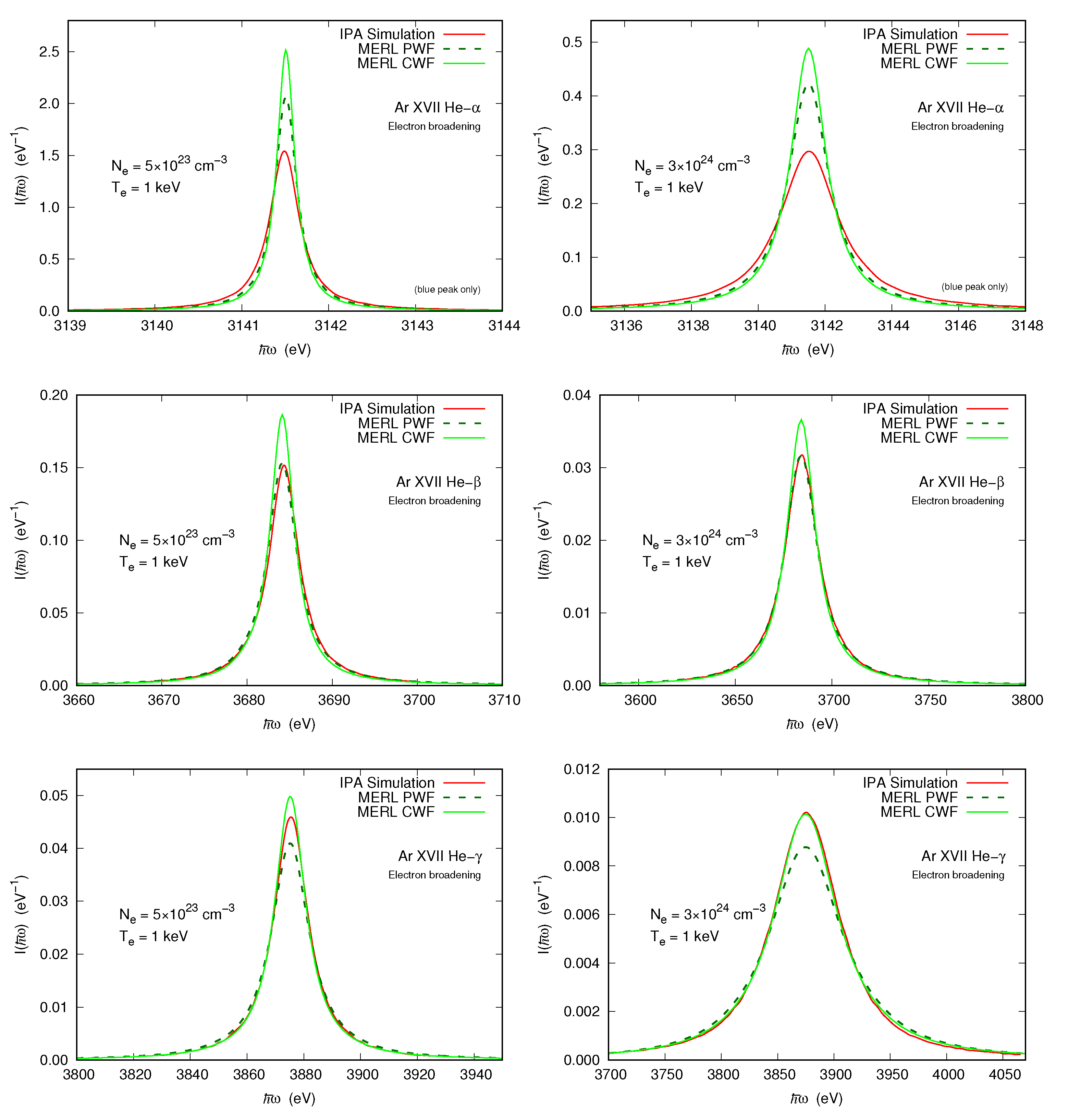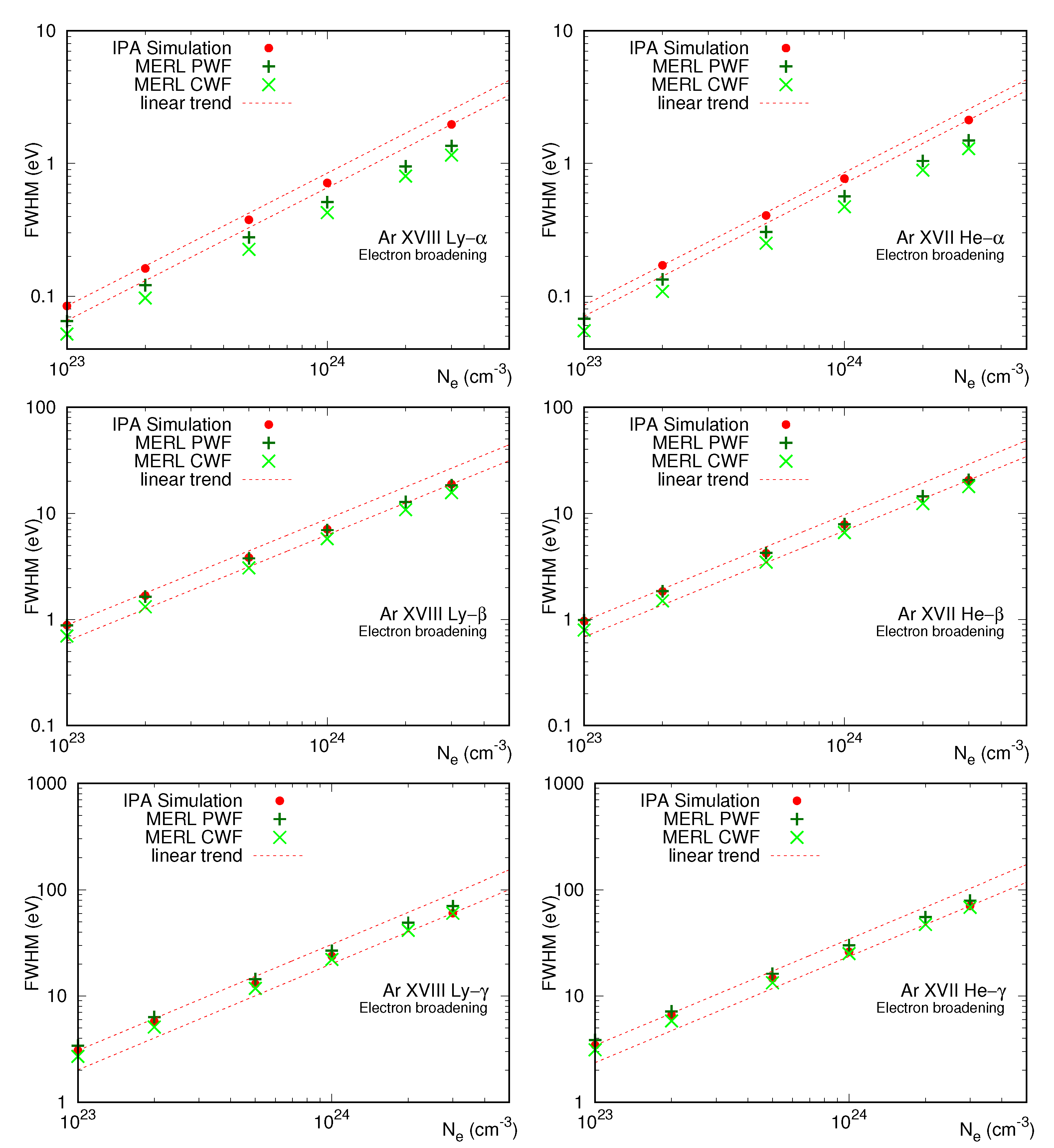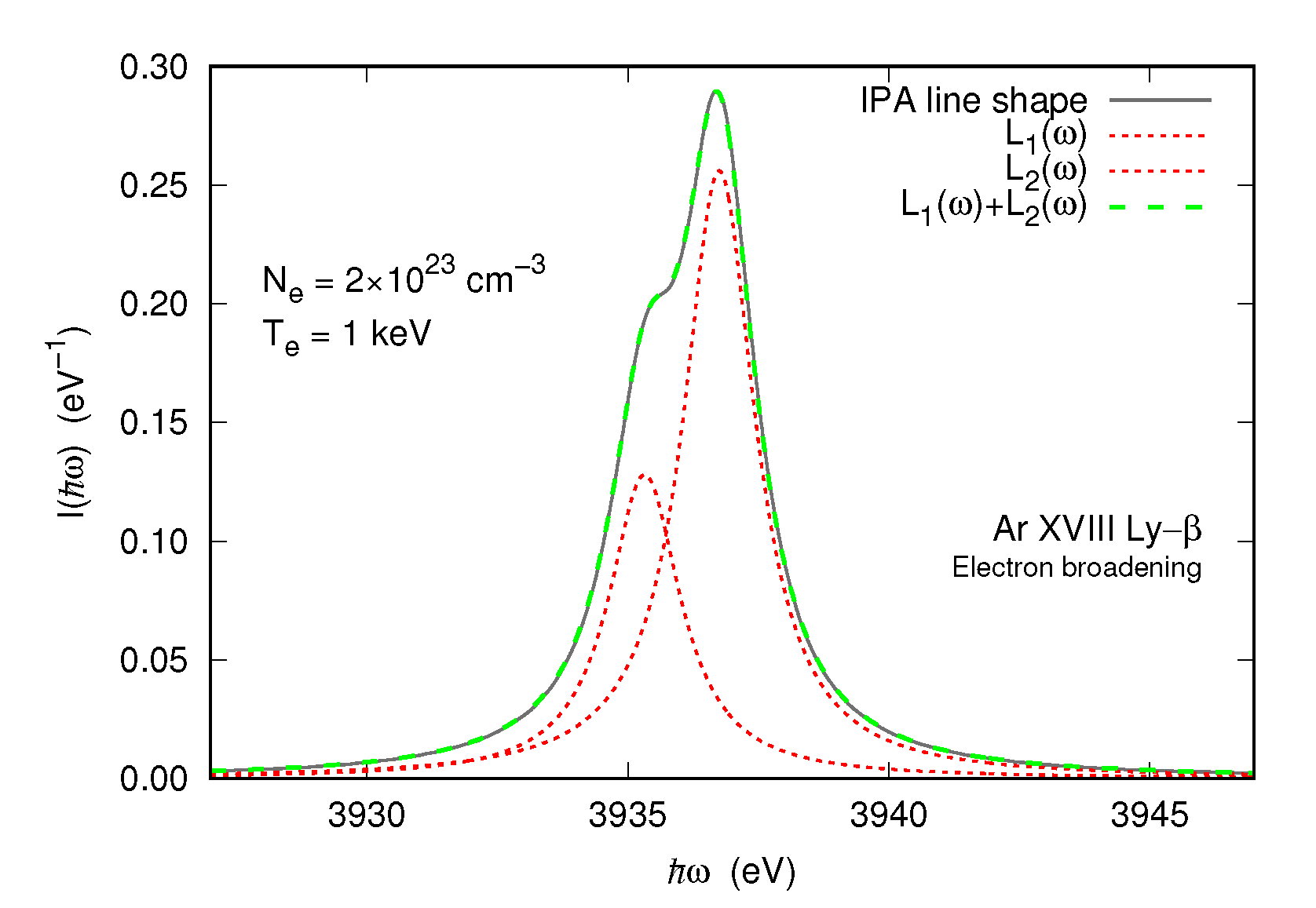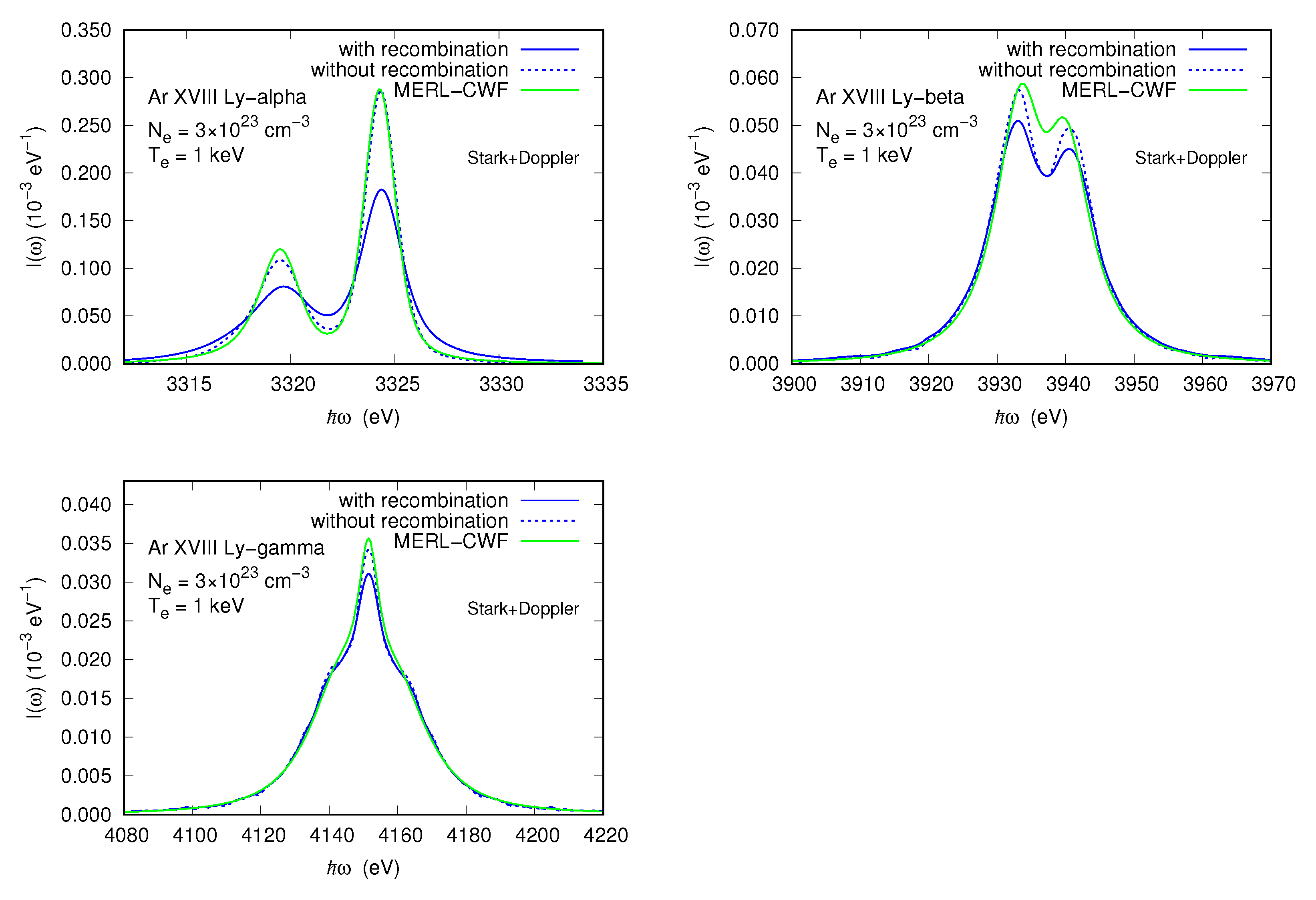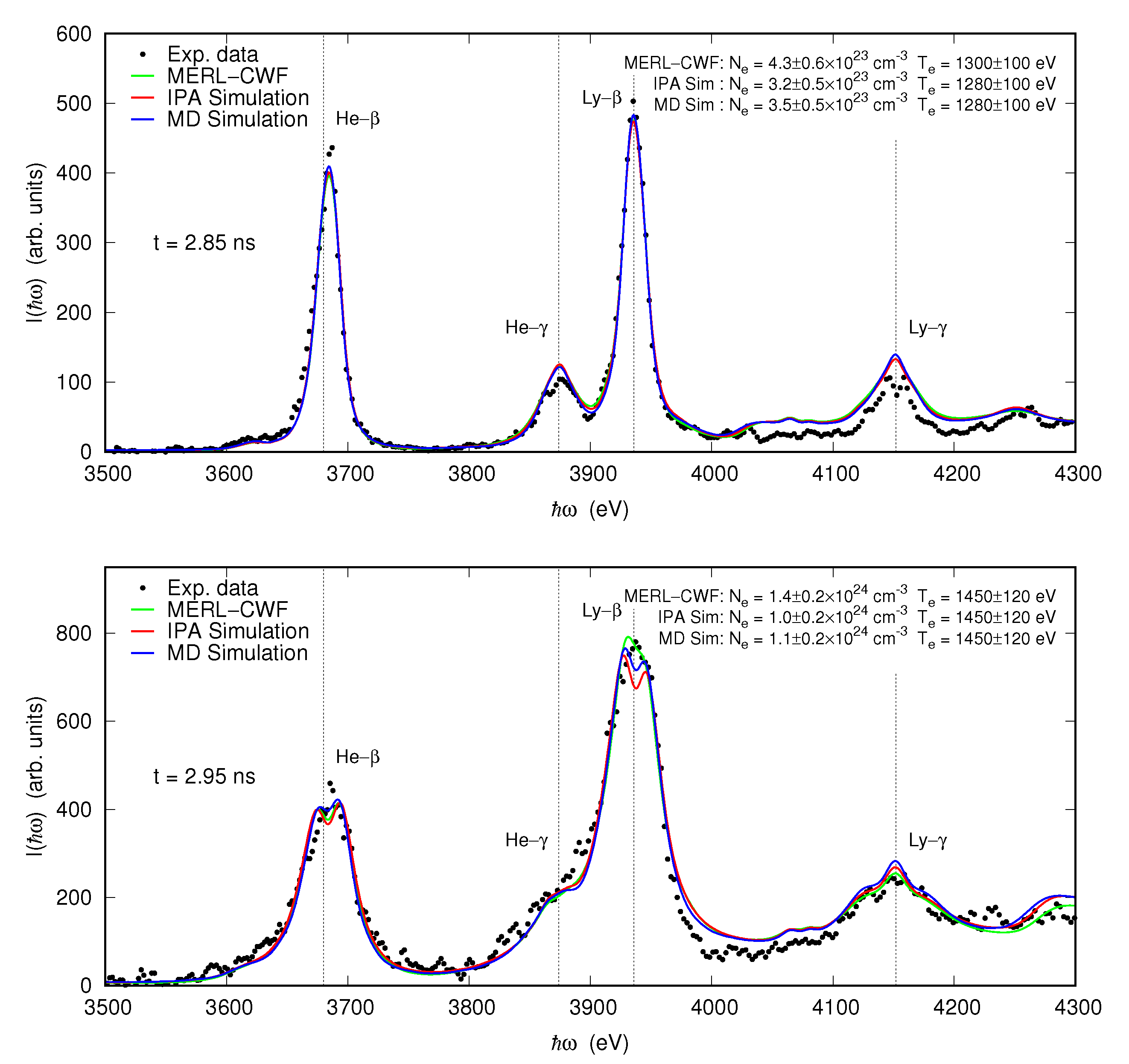Next we discuss the results for the Stark-broadened line shapes in He- and H-like argon ions. We note in passing that the accuracy of atomic structure calculations provided by widely used computational codes in the community may have an impact on the Stark-effect [
27]. However, in this work we aim to address a comparison between different Stark-broadening models. Accordingly, to remove any dependency on atomic data source, for the calculations shown here all Stark models used exactly the same fundamental atomic physics data, i.e., the same collection of fine-structure atomic energy levels, transition energies and electric-dipole matrix elements. Thus differences between Stark broadened line shape models are exclusively due to their distinctive features and nature. Data was obtained using the semi-relativistic Cowan’s atomic structure code [
28,
29], including configuration-interaction and electronic correlation corrections. Despite deviations compared to other codes and benchmark data [
27], Cowan’s code data certainly remains appropriate for the cross-comparison study performed here. Also, given the considered K-shell line transitions, field mixing between the upper (initial) and lower (final) states was neglected due to the large energy separation between upper and lower states; this is the non-quenching approximation.
3.1. Electron Broadening
Stark-broadening models based on the standard theory separate the electron and ion contributions of the perturbing electric field. The electron broadening constitutes the main mechanism contributing to the line width and is also where a major part of the physics and model approximations reside. Hence, a comparative study of electron broadening calculations against idealized experiments such as those provided by computer simulations is useful for theoretical model improvement.
Figure 1 show calculations of the electron broadening function,
, for
,
and
line transitions at two electron density values within the range of interest. MERL calculations were done using both PWF and CWF. Results from the IPA simulation are also shown. MD results are not plotted because electron-broadened line shapes cannot be rigorously calculated using MD due its own nature. When considering interacting ions and electrons, their contributions cannot be isolated. For instance, in a MD simulation many electrons indeed closely follow the ions and inherit their slow movement—the correlation between the ion field and the electron one in fact gives rise to the Debye screening. Thus, even though tentative electron-broadened line shapes could be calculated from MD simulations by taking only the electric field generated by the electrons, this field would be in fact affected by the ions. Therefore, the corresponding comparison would not be fair and might lead to ambiguous conclusions.
As seen in
Figure 1, MERL-CWF always provides narrower profiles than MERL-PWF. A plausible interpretation could be that the effective electron-radiator interaction time is smaller when using CWFs, the perturbing field correlation decays faster and this leads to a narrower line. On the other hand, since straight-line trajectories are the classical counterpart to PWFs, one would had expected a good agreement between IPA and MERL-PWF. However, results do not show such a regular trend, but a transition-dependent one. For
-transitions, both MERL-PWF and CWF lines are narrower than IPA calculations, but for high-
n transition lines, e.g., see the plot for He
, MERL-PWF predicts broader line profiles.
Figure 2 shows the electron-broadening FWHM dependency on electron density for argon He
, He
, He
, Ly
, Ly
, and Ly
lines. For the He-like transitions the two fine-structure components, 1s
np
P
1s
S
and 1s
np
P
1s
S
, are well-separated in energy, but the high-energy component, 1s
np
P
1s
S
, is much more intense, so its line-width can be easily determined. For H-like line transitions, the blue component,
np
P
1s
S
, is also the dominant one, but their relative intensities are not dramatically different and can significantly overlap for
and
transitions at higher density values. For these cases, fitting the line profile using a two-Lorentzian linear combination allowed us to efficiently extract the line-width of each component see
Figure 3. For the sake of clarity, only the FWHMs corresponding to the dominant component are plotted in
Figure 2. Also, straight lines indicating the strictly linear dependency on electron density have been added for reference. Overall, both IPA and MERL calculations agree well with the following trend:
, with
. We notice that MERL-PWF slightly deviates from this behavior. In particular, electron broadening calculations from MERL-PWF and IPA show good agreement for
-transitions over the entire electron density range. This is an important result because, as discussed in
Section 3.4, plasma diagnosis based on spectroscopic analysis often relies on relative intensity distribution and line widths of
lines to extract temperature and density, respectively.
Interestingly, for a given line transition, the line width (FWHM) ratio between MERL calculations and IPA results remains reasonably constant for the whole density range, therefore the discrepancies between models in the electron broadening treatment are reduced to a factor with a weak dependence on density. This seems clear when one goes deeper into the details for the calculation of the electron broadening operator in MERL. Typically, the
matrix elements, see for instance Equation (
3) of Ref. [
30], factorizes in two terms. The first one expresses the fact that the electron broadening operator scales with plasma conditions as ∼
—which is basically the density-dependency found from our results. The second one, which has a complicated but weak dependency on density, contains the fundamental atomic physics data relative to the state of the atomic system, and, more importantly, a function describing the interaction between the radiator and the perturbing electrons. It is plausible to think that differences between MERL and IPA come from how this latter function accounts for the statistical properties of the time-dependent field produced by the fast-moving electrons.
3.2. Complete Line Shapes
Next we address the comparative study of complete line shapes, i.e., besides the collisional electron broadening, other broadening mechanisms such as the one generated by the quasi-static ion field and ion dynamics effect are now considered. We are particularly interested in investigating the Stark-broadening of line transitions in K-shell Ar ions embedded in a deuterium plasma, since this has been the application scenario of K-shell spectroscopic analysis in multiple ICF direct- and indirect-drive experiments. As deuterium ions are ∼20 times lighter than argon ions, ion dynamics play an important role in this case. We remind that all the referred broadening mechanisms naturally and simultaneously appear in the computer simulations. Additionally, the MD simulation also accounts for the recombination broadening that arises as a consequence of emitter recombination. Further details about this phenomenon are discussed in
Section 3.3. Here we restrict to the comparison between different models. Lastly, given the temperature regime achieved in typical ICF plasmas, Doppler broadening must be also considered. For the representative temperature of 1000 eV, characteristic Doppler FWHM value is ≲2 eV.
In
Figure 4 we present a comparison of complete area-normalized line shapes calculated using MERL-CWF, and IPA and MD simulations for Ly
, Ly
, and Ly
at two representative electron densities. Compared to the electron-broadened ones, profiles show the characteristic structure that appears due to the quasi-static ion microfield, i.e., Ly
preserves the double-peaked shape from the electron-broadened fine-structure components now further broadened due to the ion microfield effect, Ly
has a distinctive double-peaked shape with a central dip that arises from the Stark energy level splitting and field-mixing, and Ly
presents an unshifted central peak with two side-shoulders. As expected, for a given transition, line shape broadens as density increases. When comparing different models, MERL-CWF predicts narrower profiles for all the cases. Differences between MERL-CWF line shapes and those provided by simulations are noticeable for
lines and less pronounced for
and
transitions, which suggests that the general trend already observed when considering only the electron broadening survives after accounting for additional broadening mechanisms. We also observed that for
and
transitions the MD simulation produces narrower line shapes than IPA. The simulation with interacting particles provides electric field statistics shifted to weaker values compared to that resulting from a simulation with non-interacting particles, which leads to narrower spectra in general. However, for
lines, the opposite behavior is observed, i.e., the IPA line shape is narrower than the MD one. This is because the Stark-broadening is indeed much smaller for the
line than for higher-
n transitions and therefore the impact of the recombination broadening—which naturally appears in the MD simulation, but does not exist in IPA—relative to the Stark-effect is more pronounced. The Stark-broadening dominates for
and
lines, and recombination effect becomes less important. The same qualitative behavior was observed in the complete profiles of He-like Ar line transitions.
3.3. Recombination Broadening
As discussed above, when a free electron is
trapped by an argon ion, the line emission process interrupts and the dipole autocorrelation function abruptly drops to zero, which in turn translates into an additional broadening of the line. The criterium to identify an
electron trapping was already described in
Section 2.1.2. To assess the impact of this phenomenon on the line profiles we carried out two different calculations. The first one indeed corresponds to a standard calculation, and this is why we have emphasized that MD simulation naturally tackles the recombination process. Within a classical picture, the MD code solves the plasma particle dynamics including the argon ions. Each simulation run provides multiple time-histories of the electric microfield,
, perturbing a given argon ion. In a simulation run at given plasma conditions the time-histories are computed till a time
T greater than the average correlation-loss time of the emitting dipole, i.e.,
, with
denoting the average over the statistical ensemble. Field time-histories are stored and then used to solve the Schrödinger equation, Equation (
3), to ultimately computing the dipole autocorrelation function. If over a particular time-history,
, recombination occurs, such sequence is terminated, but still considered on the same footing with the remaining time-histories to proceed with the line shape calculation. For the second calculation, field time-histories affected by an electron trapping are removed and the average autocorrelation function is computed using only field sequences seen by non-recombining ions.
Figure 5 shows line shapes computed with and without the
recombination broadening for H-like Ar transitions, i.e., Ly
, Ly
, and Ly
, at
cm
. Similar qualitative results were found for He-like lines and different density conditions. The
electron trapping gives rise to a broadening mechanism to be added to the Stark-broadening. Conceptually, this phenomenon can be described in terms of the standard Lorentz model, where the line width represents a measure of the rate of atomic processes that abruptly produce a coherence break. Within a classical framework, the recombination rate does not depend on the emitter internal state—there is no such distinction when simulating the particle dynamics—and therefore within the same ion stage the recombination broadening does not depend on the line transition. In this context, if the Stark-broadening is rather small for a particular line, then the additional recombination broadening can be relevant and should be taken into account for an eventual spectroscopic analysis, e.g., this is the case of Ly
. For lines affected by a strong Stark-broadening, this phenomenon becomes less important, as happens for
and
transitions.
In this regard, a recent work [
8] emphasized the role of
electron-capture (EC) on spectral line broadening in hot dense plasmas. It is important to note that here EC refers to the atomic process that occurs when a free electron is captured by an ion, i.e., recombines, and after some energy distribution the recombined ion ends up in a doubly excited or autoionizing state. Another well-known recombination process is the
three-body recombination (3BR), i.e., two electrons enter at the same time into the volume of one ion and one of the two is captured in a bound state, whereas the other takes up the extra energy [
31]. In the case of our classical MD simulations, the observed recombination process has not—if any—a clear quantum-mechanical counterpart. This is why we pointedly have referred to it simply as
recombination or
electron trapping, thus eluding a straightforward association with either EC or 3BR. Since the MD simulation does not include dissipative radiative processes, the classical recombination cannot account for the
radiative recombination process, so it would rather represent a joint effect due to EC and 3BR. In Ref. [
8] authors point out that EC might have a significant effect on
lines, but negligible for higher-
n transitions, which would be due to the reduced number of EC channels and weaker interaction with increasing
n. Interestingly, our results show the same qualitative behavior. Moreover, we notice that MERL calculations—where no recombination process was included—agree better with the MD line shapes without recombination broadening. Further investigations are needed to answer the open questions on this topic. Here we limit ourselves to report the performed calculations and to warn about the impact of recombination broadening on the line shapes.
3.4. Impact of Stark-Broadening Models on the Spectroscopic Diagnosis of OMEGA Implosions
The differences in the line shapes discussed in the previous section motivate the question of how much the use of different line shape codes may impact a spectroscopic diagnosis analysis. To investigate this issue, we performed the analysis of time-resolved Ar K-shell spectra recorded in direct-drive implosion experiments conducted in OMEGA [
32]. The experiments consisted of imploding spherical plastic shells which had an initial diameter of 435
m, wall-thickness of 27
m and an outer Al sealing layer of 0.1
m. They were filled with 20 atm of D
and a tracer amount of Ar, 0.072 atm, for spectroscopic purposes. The emission from Ar K-shell lines becomes bright at the collapse of the implosion, when the imploded core temperature reaches the keV-range and electron density increases above 10
cm
. An X-ray streaked spectrometer with a spectral resolving power
was fielded in order to record the time-resolved space-integrated spectrum spanning the photon energy range from 3000 to 4300 eV.
The model to analyze the data consists of a spherical plasma source with uniform electron temperature,
, and density,
, representing the imploded core. The core radius
R can be determined from
assuming mass conservation. For such geometry the radiation transport equation can be analytically integrated, and the emergent intensity distribution
is given by [
33]
where
is the angular photon frequency, and
and
stand for the temperature-, density- and frequency-dependent emissivity and opacity of the core. The required emissivities, opacities and atomic level population distributions were calculated with the collisional-radiative atomic-kinetics model ABAKO [
34] over a sufficiently wide range of temperatures and densities. All bound-bound, bound-free and free-free contributions from the Ar-doped deuterium plasma within the data spectral range were included. In particular, bound-free cross-sections were calculated with the LANL suite of codes [
29].
For this application an ABAKO model for argon was constructed including up to 4592 energy levels from fully stripped through C-like Ar. Energy levels and line transition rates were computed with the atomic structure code FAC under the relativistic-detailed-configuration-approach (RDCA), including unresolved transition arrays [
35] and configuration interaction corrections. The current version of ABAKO includes a module that automatically executes FAC to compute the energy level structure and related fundamental atomic data to subsequently build the collisional-radiative matrix ensuring state-space completeness for the corresponding application. Other than that there is no particular reason for using either FAC, Cowan’s or similar codes. There is no inconsistency in using FAC for the atomic kinetics and Cowan’s data for line shape calculations. Note in turn that, in this work, when computing the emergent spectra using different line shape models, the atomic kinetics model remains indeed the same. Therefore, different results will be only due to the distinctive features of Stark-broadening models. Moreover, for line shapes calculations, populations of fine-structure levels belonging to the initial state were assumed to distribute according to their statistical weights (for the case of IPA and MD simulations) or to follow the Boltzmann statistics (MERL calculations). For the application discussed here, in the context of hot dense plasmas, these assumptions are both equivalent and well-justified: (a) collisional processes domain the relative population distribution among fine-strcuture levels, and (b) characteristic temperatures are much greater than energy differences between fine-structure levels, i.e.,
.
For given plasma conditions, ABAKO explicitly includes all non-autoionizing and autoionizing states consistent with the corresponding ionization potential depression, which is estimated according to the Stewart-Pyatt model [
36], modified to account for the argon-deuterium mixture. An escape factor model was used to account for radiation trapping effects on the atomic-level population kinetics [
37].
Importantly for this investigation, Stark-broadened line shapes for Ar , , and were calculated for density values from to cm using three different models: MERL-CWF, and the IPA and MD computer simulations. Since line shapes sensitivity with temperature is small, all calculations were done at the representative value of 1 keV. Synthetic spectra also include detailed Stark profiles for Li-like satellites of () and (), and He-like satellites of (); however due to the high computational demand of simulation models, only MERL-CWF was used to calculate the line shapes of satellite transitions. This fact does not override our study on model dependence because, although satellites are needed for better modeling the observed spectra, the analysis results mostly rely on the representation of the corresponding parent lines.
Furthermore, for the plasma conditions of these implosions, characteristic optical depth values for argon line transitions are: for the and lines, for the and , and for the and . Therefore, besides the intrinsic difficulties for properly modeling the profiles, lines are much more sensitive to spatial gradients and absorption effects than others. This is the reason why density diagnostics based on K-shell spectroscopy usually rely on the and lines region of the spectrum. Accordingly, the analysis of the time-resolved Ar K-shell spectra measured in the OMEGA implosions was carried out for the photon energy interval from 3500 to 4300 eV, thus including , , and lines. Thus, despite the discrepancies observed between MERL and simulation results on the line shapes, the study of spectroscopic analysis dependence on line shape models turns into an assessment of the impact of differences observed in line shapes, and ones to a lesser extent.
As an illustration,
Figure 6 shows the analysis of three time-resolved spectra recorded in OMEGA shot 49956 from earlier to later times through the collapse of the implosion. For this application, we used ABAKO and the three referred line shape models to build three databases of
synthetic spectra—following Equation (
12)—on the intervals
eV and
cm
for electron temperature and density, respectively. For each model, an exhaustive search on the two-dimensional parameter space following a weighted-
minimization procedure was done to find the best model fit and confirm that a single global minimum was found. As seen, the three models were able to produce good fits to data (with
) and extracted conditions are consistent with the implosion dynamics and analysis discussed in previous works [
38,
39]. Extracted temperature values are very similar. This is because temperature sensitivity mainly depends on the relative distribution of line intensities through temperature-dependent population densities and the atomic kinetics model remains unchanged in the three calculations discussed here. Density sensitivity mostly relies on Stark-broadening of the line shapes, so greater differences between models are found in the extracted density values. MERL-CWF always yields higher densities, while IPA simulation the lowest ones. This agrees with the results found in the previous section, where for a given density value, MERL-CWF produced the narrowest line shape and IPA the broadest one. Relative to MD simulation results, extracted densities are ∼25% higher for MERL-CWF and ∼10% lower for IPA. This level of discrepancy agrees with the one reported in several works for different line shape models and methods [
6,
7]. To quantify to what extent these discrepancies reveal an impact on K-shell spectroscopy, one needs to take into account the inherent uncertainties in the data analysis. Statistical uncertainties in the parameters associated with the minimization procedure were computed as the standard confidence limits on temperature and density, which in turn result from a curvature analysis of the two-dimensional weighted-
surface about the minimum, taking into account the correlation between the parameters. Additional uncertainties come from the data-processing itself (mainly from the subtraction of background continuum emission, which is applied to the experimental spectrum before the comparison with the synthetic spectra) [
32]. Accounting for all these factors, we estimated a total uncertainty of ∼8% in temperature and ∼15% in density. Therefore, extracted temperature values are clearly within uncertainties. Results of density diagnosis using both simulation models are likewise indistinguishable considering the data analysis uncertainty. On the other hand, density values extracted from MERL-CWF and those determined from the simulations overlap at about the limit of the corresponding uncertainty intervals. In conclusion, our analysis minimizes the impact due to the use of different line shape models on the K-shell spectroscopy analysis of implosion experiments at OMEGA, and validate the results obtained by either of the three models discussed here.
